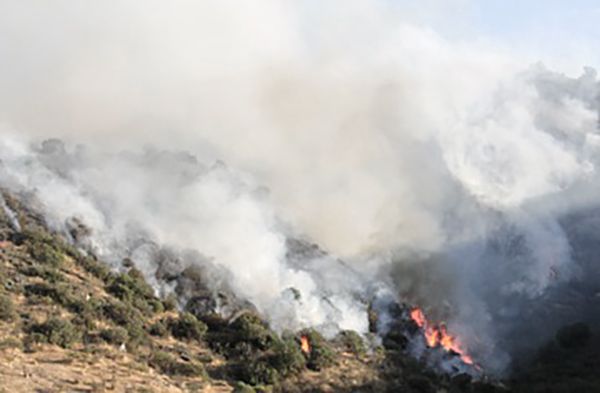The pilot and sole occupant of a single-engine Air Tractor AT-802F was killed when the aircraft went down during a nighttime firefighting mission near Colorado’s Estes Park on Tuesday. The aircraft, which was owned by Co Fire Aviation, departed from Northern Colorado Regional Airport (FNL) in Loveland a little before 6:15 p.m. local time on a flight that was meant to mark the first time a fixed-wing aircraft had dropped suppressant on a fire at night in Colorado. The pilot was identified on Thursday as Marc Thor Olson.
“The Co Fire Aviation family is deeply saddened by the sudden, tragic loss of one of our brothers serving as a tanker pilot,” CO Fire Aviation said in a statement. “Marc Thor Olson was a highly decorated veteran of both the Army and Air Force with 32 years of service to our country. During Thor’s 42 years of flight, he had amassed more than 8,000 total flight hours with an impressive 1,000 hours of NVG flight including in combat and civilian flight.”
The crash occurred at approximately 6:37 p.m. local time and the accident site was located at around 9:49 p.m. According to the Larimer County Sheriff’s Office, Olson reported just prior to the crash that “it was turbulent over the fire, conditions were not ideal to make a drop, and that he was going to make one more pass and then return to Loveland.” Olson had successfully completed a water drop at the site about an hour earlier. The NTSB is investigating.




































God bless this man and his family.
It’s hard to imagine how incredibly dangerous aerial firefighting must be, much more so in the smoke in the dark in the turbulence and alone.
For 7 years I flew a C185F scout plane on forest fires mostly in the mountains. I worked with single engine air tankers and helicopters that dropped water on forest fires. This was during the day when we could see the terrain around us. At night the mountains are invisible in the darkness. I’ve never flown with night vision goggles (NVG) but it must be unbelievably dangerous since the light from the fires reduces the effectiveness of the NVGs. Big fires create their own weather including extreme turbulence, heat and smoke that blocks visibility and makes breathing more difficult. When you are flying just above the trees to do the drops at 90 knots with a heavily loaded aircraft, your ability to maneuver the aircraft is reduced. Combine all of these risk factors and it’s hard to imagine a more dangerous flight operation. My thoughts go out to his family.
Who did the risk assessment prior to this flight? I don’t know anything about aerial firefighting, but I don’t see how the matrix would not have put this deep into the red category. A perfectly good airplane and experienced pilot lost for what–to save a few acres that could have waited for daylight? R.I.P. brother…
These were my initial thoughts as well. However, neither you nor I were there at the time the decision to take on the mission was made. There may have been factors, both in the situation, and within the minds of the pilot and organization which suggested that the risks were capable of being mitigated. It is very a very unfortunate tragedy that, in retrospect, it appears that assessment might have not been correct.
There are procedures for fighting forest fires at night, some include a spotter aircraft.
Training is a factor.
Some awareness of the effort can be gained from https://www.coulsonaviationusa.com/newsmedia/part-1-nighttime-aerial-firefighting-innovation.
Question is obviously how to know where the terrain is.
Of course turbulence is a concern, common around fires.
Coulson’s C-130 graphic shows what probably is an S-76 of later than original vintage given engine exhaust shape. Coulson operates at least one S-76 with imaging equipment like Flir and low-light-level sensors, and communications equipment including datalink.
Coulson lost a C-130 in Australia, in circumstances that suggest an experienced firefighting crew got too low turning into rising terrain, in daylight but patchy smoke and perhaps turbulence – but investigators are still examining items of wreckage thoroughly, engine or other system faltering are possibilities to be checked into.
I recall one scenario with heavy aircraft, in which the night fighting crew went over the terrain in daylight to familiarize with the scene, while day crew took a break. Sounds smart.
And this article may be instructive: https://www.airmedandrescue.com/latest/long-read/nighttime-firefighting
And converting helicopters into UAVs for fire fighting: https://www.popsci.com/story/technology/erickson-air-crane-converting/
I read that they are installing other upgrades in the machine at the same time, at least some like FBW probably supporting UAV piloting, hence a lot of work needed.
Hope they do better than Sikorsky did with Canadian Navy Cyclones, looong development process for first FBW S-92 and one crashed because of software overlooking a condition of machine-pilot interaction.
R.I.P. Mr. Olson. Thank you, and your family, for your service and sacrifice.